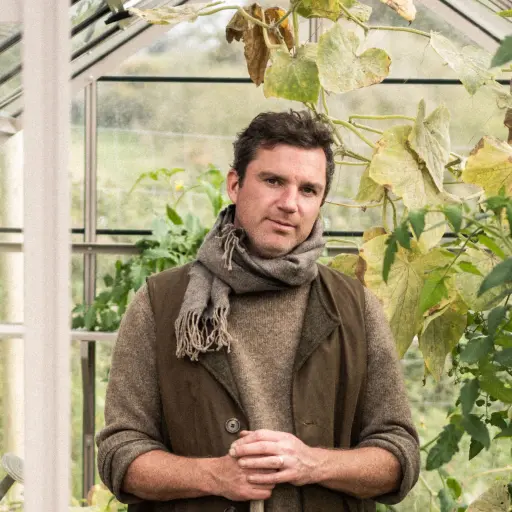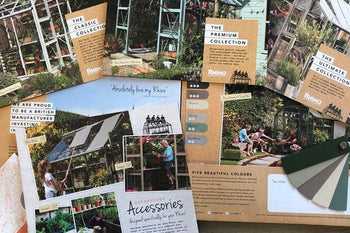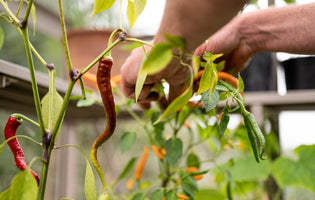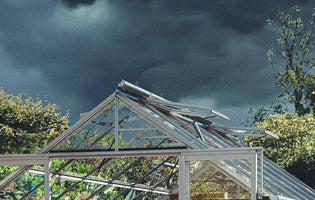Yesterday I heard a cuckoo call from across the valley. It took me by surprise because it’s not a bird we hear that often. It’s a migratory bird; arriving around April to breed, sneakily tricking Dunnocks and Meadow pipits into raising its young, so it can leave for Africa in June. They are called brood parasites, but have the most wonderful, lulling call, mesmerizing almost – ‘cuck-oo’.
This is my third spring in the vegetable garden and it’s such a pleasure. I just love being there. I find it incredibly calming. Sowing seeds, potting things on, weeding. Sometimes I’ll just catch myself staring at plants for ages – just thinking, often about nothing. I’m able to switch off in the veg garden, but alongside that, I can be really productive too. That’s what’s so lovely about it, you’re able to create, to grow, to bring life and none of it is stressful.
Our biggest success of the spring has been our homemade compost. It’s taken a long time to get to where we are now, but I feel at last, we are in motion. We are part of a sustainable, cyclic activity and it’s immensely rewarding. Nearly every single seed we’ve sown has been plunged into our own dark, rich & initially very course (until we picked up a soil sieve in a brocante in Burgundy) compost. I have to say; our own compost is so, so much better than anything we’ve used before. Not only is it essentially free, the plants seem to flourish in it. They look vigorous and bright. Their stems are thick and strong, while their leaves are broad and fleshy. It’s quite amazing to see the difference side by side. In fact, about 2 months ago I decided to plant up a selection of big terracotta pots I had in the greenhouse with beetroot. One of these pots already contained some compost while the others were filled with spadefuls of our own stuff. The results are simply incomparable.
Generally, it feels a bit colder than this time last year, but I’m not sure of it. Seeds have been germinating and young plants are gradually leaving the safety and warmth of the greenhouse although some get to stay inside for the duration. We’ve been cutting rows of mixed peppery salad leaves since January and pulling radish since late Feb. It’s so nice to have a few home grown ingredients that early in the year. I’ve been planting out lots of lettuce in staggered rows. I bring them on in seed trays sown a few weeks apart and then when they’re big enough they go out into the raised beds. I’ve been planting out young Tuscan black kale plants and a few cauliflower too, but I’m not sure how they will do, it’s an experiment.
2 years ago I put 8 asparagus crowns in the ground and now after much patience and will power we have begun to harvest them. It’s been such a pleasure to cut our own spears and bring them straight into the kitchen to cook. We’ve been having them for breakfast with boiled eggs and smoked trout or for supper with roast chicken and sorrel sauce. It’s wonderfully sweet when you eat it so fresh and the texture is almost nutty.
I put a few seed potatoes in the ground a couple of weeks ago. This time I went for Rocket and Foremost, 2 varieties I haven’t tried growing yet, but they come recommended. Their military green leaves are just beginning to emerge from the soil and hopefully in a few months well be sitting down to freshly dug boiled new potatoes with lots of butter, black pepper and flaky sea salt – just delicious and with that in mind, here’s a recipe with a slight variation on that theme.
New potatoes with elder flower and lemon thyme
The elder tree in flower has become such a part of spring that it’s now far more than a tree to me. It is a declaration from nature; her quiet voice asking that we look around us. The earth on freshly dug new potatoes, their shape and the fragrance of their fragile skins have a similar resonance. The two together, served like this, are perhaps a thank you on my part, but beyond and above that notion, they are simply delicious.
Ingredients
800g (1lb 12oz) new potatoes, cut into equal-sized pieces
100g (31⁄2oz) unsalted butter
2–3 elder flower heads
Finely grated zest of 1 lemon
1 small handful of lemon thyme (or normal thyme), leaves picked and roughly chopped
Sea salt and freshly ground black pepper
Method
Place the potatoes in a large pan and cover with plenty of salted water. Pop the pan on a high heat and bring to the simmer. Cook the potatoes for 10–20 minutes, or until they are tender when pierced with the tip of a knife. (The cooking time can vary depending on their size, variety and freshness.)
Drain the potatoes and return them to the pan. Add the butter, elder flower heads, lemon zest and lemon thyme. Season well with salt and pepper, turn together and set aside to rest for a few minutes, then spoon the buttery potatoes into a warm bowl or dish and serve.









